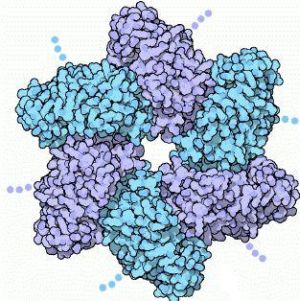User:Kristen Russo/Sandbox2 1N25
From Proteopedia
|
Contents |
Introduction
Large T-antigen (LTag) is a viral oncoprotein derived from the polyomavirus SV40 (Simian virus 40). SV40 was first identified in the cultures of Asian rhesus monkeys in 1960. SV40 infects primate cells by forcing its way into the cells and releasing its DNA. Once inside, the DNA replicates and packages it in new viral capsids. SV40 uses the T-antigen protein to control both of these processes. There are three functional parts to the T-antigen. The first part is the LTag , which forms a six-fold ring by assembling with several other copies of the protein. The hole in the middle encircles a DNA double helix.
The other two functional parts of the T-antigen are: the central domain which has a small patch and anchors the T-antigen to the SV40 genome by binding to the regulatory region, and the third domain which interacts with cellular proteins, therefore directing the different stages of the viral life cycle. There are 12 copies of the T-antigen protein which forms a long tube around the DNA. Although there are three parts to the T-antigen, LTag is the fragment that seems to be associated with the formation of cancer. LTag is a member of the helicase family III, and has been known to hinder the function of cellular tumor suppressors, such as p53. P53 is important because it has the ability to either stop the cell cycle and allow for DNA repair, or to cause apoptosis. This p53 gene is found mutated in more than 50% of human cancers. LTag targets and inhibits p53 function, which ends up deregulating cellular growth control.
LTag
LTag carries on several different functions that allow for viral replication. LTag oligomerizes into a double hexamer which binds to the viral origin of replication. This forms a prinitiation complex that melts, and ultimately unwinds the double-stranded DNA. After the formation of this complex, LTag works in coordination with certain host proteins (such as topoisomerase I) to promote bidirectional replication. The of LTag
How does LTag inhibit p53?
LTag forms a complex with p53 using its helicase domain (residues 251-677). The complex is composed of one LTag hexamer, binding with one monomeric p53 (which is 6 p53s). LTag alpha helix h15 binds to the p53 region 1. This makes one assymetric unit, which are arranged in 2 copies. The p53 region 1 may play a significant role when bound to DNA, in stabilizing p53 tetramer, so the binding of LTag may actually interefere with the tetramerizationof p53. LTag's h15 and h16 residues binds to region 2 of p53 forming both hydrophilic and hydrophobic side chains. The most significant interaction in region 2 is LTag's D402 binding to p53's R248. In human cancers, this R248 is known to be the most frequently mutated residue, which leads to the assumption that the binding of LTag could be the reason for this mutation. Within this region, LTag also has a hydrophobic pocket. This pocket is composed of residues L609, Y612, W581, and Y582. This pocket forms a strong hydrophobic interaction to the p53 residue M246, and it plays a very important role in the overall binding of LTag to p53.
Medical Significance
Although SV40 originated in monekys, it is believed that the inoculation of about 98 million people back in 1960 with a contaminated polio vaccine was the major route of SV40 into humans. Today, SV40 DNA sequences are found in 50-70% of mesotheliomas and 70-90% of ependymomas. Many experiments are done to see if SV40 is present in human peripheral blood samples, and also whether it plays a role in human leukemias and lymphomas. In a study where 266 samples of human blood samples were studied, SV40 was found in 7 of 11 patients with AIDS related lymphomas. Not only was SV40 found, but the T-antigen signal was clear while the VP (a different region of the SV40 protein) was insignificant.

